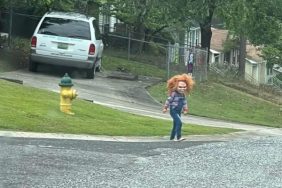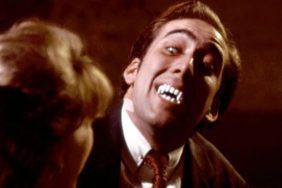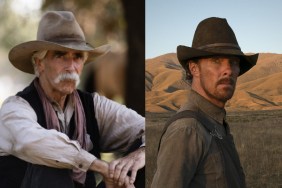Welcome, foolish mortals, to the latest lecture in CraveOnline’s Free Film School. Kick back, napkin up the blood and entrails, and smile wide. We’re going to delve, as one would in October, into another corner of horror movies.
The phrase “Master of Horror” is tossed around a lot these days, especially in these precious days leading up to Halloween, a time when all the local cable outlets and single-screen movie houses have devoted their entire calendars to horror films of yore. Dozens of famous filmmaking names are hauled out during this time, and, in addition to the usual heavy-hitters like John Carpenter and Tobe Hooper, anyone who has directed a horror film in the past is given the coveted-cum-dubious mantle of Master. Eli Roth has, for instance, only directed three feature films to date, but because of his active participation in other horror products, has already been called a “Master of Horror.” Lucky McKee was deemed enough of a Master to participate in the TV series of the same name, even though he had, at the time, only completed one feature film.
Looking over these programs, you’ll find several generations of men (and they are typically men) who are obsessed with monsters or who, at the very least, have enough acumen and interest to direct monster and horror films with adeptness. Listening to any of them talk about their pictures, you’ll find that any director who is known for making horror films will be chock full of stories of childhood experiences sitting in their local cinemas, eating candies, staring in rapt attention at the monster movies of their youths. Invariably, the Masters of Horror will attempt to relate how this ineffable childhood interest in monster movies directly relates to their present-day skill in making their own. One generation will cite the generation previous, and so on.
Follow that path back far enough, though, and you may find the first great American Master of Horror at some point. After all, we can only go back so far before we run into a generation of filmmakers who didn’t grow up with movies; the first to pioneer the film trends. Sure, there were famous horror movies and horror filmmakers before him (I will eventually give a lecture on the famous silent vampire film Nosferatu and its famous director F.W. Murnau), but the following fellow is easily the first great American filmmaker to take an active interest in all things weird and horrific, making some of the cinema’s most twisted horror movies. Let’s take a look at Tod Browning.

Browning is, to offer a brief word of context, the man who directed the 1931 Universal classic Dracula. And while many of the directors employed by studios back in the late 1920s and early 1930s were working stiffs who churned out product at a rate so rapid it would make Takashi Miike’s head spin, Browning (as well as some of his equally well-known horror movie kin, amongst them James Whale, director of Frankenstein) was more of an auteur. He was genuinely interested in the criminals, monsters, and freaks he filmed, and wholeheartedly displayed his love for the grotesque on the screen. Like John Waters, who would make movies decades later, Browning was a man consumed by passion for the bizarre. No mere shock jockey, Browning was possessed of an unstoppable urge to relate his own personal loves to audiences. To many they looked like nightmares. To the right eyes, they are loving (if twisted) love letters to the carnies and freaks he knew during his youth. Not all of his films were horror films (indeed, he directed in just about every genre known at the time), but that is what he’s known for, and this lecture will spend most of its time discussing his more famous films. I encourage you, nonetheless, to seek out his more obscure stuff, should you be interested.
Charles Albert Browning was born in 1880, and, at the age of 16, ran away and joined the circus, back in a time when running away and joining the circus was an actual and viable career option for ambitious high school dropouts. He was a performer at heart, and loved the carnival. It was here that he changed his named to “Tod,” which is the German word for death. See, kids? Giving yourself a Goth identity was hip before the 1990s. The jump from carny barker to vaudeville performer wasn’t large, and throughout the 1890s and early 1900s, Browning directed a lot of live theater. It was here that he caught the eye of D.W. Griffith, who was essentially the Steven Spielberg of his time. Browning had graduated to feature films. By 1915, he was making silent movies on a swift and regular basis for various studios.
Like I said, Browning proved to be a skilled director in all genres, making a wide swath of melodramas, romances, and even westerns. And while many of his early films were sweetly efficient in their way (I admit, however, that I have seen few of them), it was when he was working with crime, horror, and the grotesque that he really shined. Also films about circus performers; you’ll find they are a regular motif in his films. What drew him to horror? Well, part of it must have been his personal inclinations, although many film historians like to point to a 1915 car wreck that he was involved in; he crashed a car injuring himself and killing a friend. Perhaps it was the direct horror he saw that led him to constantly exorcize it. Perhaps it was the comforting period of productivity that helped him cope with the violence that drew him to darker material. Browning was by all accounts a cheerful man, but he spent much of his life battling depression and alcoholism.
In 1919, Browning worked with a well-established character actor named Lon Chaney, and a long working relationship formed. Chaney is perhaps best known for playing the title character in 1925’s The Phantom of the Opera and for his chameleonic ability to transform his face (using impressive and painful and groundbreaking makeup techniques). Browning and Chaney would make nine features together.
Of those nine, the best is probably 1925’s The Unholy Three, which is equal parts hilarious, bizarre, and twisted. Chaney played a master ventriloquist who teams up with a malevolent dwarf (Harry Earles, a famed dwarf performer) and a dumb strong man to start their own miniature crime empire after all had been fired from the circus. Chaney goes undercover as a kindly old woman (!), and the dwarf goes as her infant grandson (!!). The unholy three do indeed go on a crime spree, gleefully causing harm and stealing. There’s not much violence in the film, but the premise is just so very bizarre, it feels more violent than it is. Lon Chaney in old lady drag. That’s why we go to the movies. The film is available on DVD, through the Warner Archive Collection. I assure you: You can buy it blind and not regret it. This is a minor silent classic.

Lon Chaney died in 1930, leaving Browning stuck for another leading man. When Universal asked him to direct a talkie based on a famous blood-soaked potboiler based on a hit play, he decided to use an unknown Hungarian actor (who had popularized the role on stage) to play the titular monster. The actor was Bela Lugosi. The film was Dracula.
1931’s Dracula is perhaps the single most famous horror movie ever made. No talk of Halloween, horror movies, or vampires can be had without some sort of spiritual nod to it. Dracula taught us about vampires in a new way, and codified, to this very day, the way vampires behave. I can’t emphasize enough how important Dracula is to the world of horror. If you haven’t seen it, then you are not yet a horror fan. If you have, you have nothing but respect for it.

As Count Dracula of Transylvania, Lugosi brought an exotic, old-world sensuality to the role of the vampire that every actor who has played Dracula since (from Christopher Lee to Adam Sandler) has only tried to emulate. Every vampire costume you find at Halloween stores is based on Lugosi’s iconic cape and medallion. What’s more, Lugosi, who has originally learned his dialogue phonetically, had a wonky and unsettling approach to his lines. He seemed to roll them around in his mouth in an almost unreal way. His performance is, at once, off-putting and mesmerizing. Browning’s approach to the material was to remain faithful to the play’s original staging, and, as a result, Dracula feels very much like a play for extended sequences. The camera rarely moves, and a lot of the exposition is delivered in impeccably laid-out theatrical frescoes that resemble dioramas more than anything. Much of the action is explained rather than shown (which, at a glance, would violate the famous filmmaking law of Show, Don’t Tell, but actually works, I think, to establish a kind of formal tone that supports the ultimate end). Dracula is, by today’s standards, a bit stiff and stodgy, and many young horror fans may become impatient with its lack of mayhem. Indeed, it’s more nearly as scary as 1922’s Nosferatu, which is infinitely weirder. But consider just how wonderfully alien Lugosi is, how grandly baroque the action is, how glibly rococo the drama is. You may find yourself falling in love.
Yes, there was a time when Bela Lugosi was considered pretty sexy. Today’s vampires are all tortured young studs who brood byronically, and don’t wear shirts. In the 1930s, though, there was a common fantasy of being whisked away by an older, rich, European aristocrat. Dracula was that whisker. Only he wanted more than to look after you. He wanted to drink your blood.

Dracula was an enormous hit for Universal, and essentially launched what would prove to be the Golden Age of the monster movie. Lugosi would go on to other monster films. Frankenstein, The Mummy, and The Invisible Man would arise in the following years, all becoming landmark films (The Wolf Man wouldn’t enter the movies until the early 1940s). Tod Browning was, thanks to his “It Boy” status, given free rein to make whatever movie he liked.
What he made is perhaps his best and easily his most disturbing film. In 1932, he released Freaks on the world.
Freaks is a movie about, well, circus freaks, and the lives they lead behind the scenes. Browning, who worked in circuses, knew all about the actual mechanical world of displaying human oddities for the public, and knew many professional freaks. He decided to cast actual carnival performers to play essentially themselves. Harry Earles from The Unholy Three would play Hans, a dwarf performer who leaves his dwarf girlfriend for a gold-digging aerialist (Leila Hyams), who is clearly extorting him for his money and openly continuing her affair with the circus strongman. Hans and the woman eventually marry, although she humiliates him at their wedding. With the aid of the other freaks, Hans eventually turns on his wife and her boyfriend, killing him and somehow mutilating her beyond recognition. This story, however, is only about half the film. Much of Freaks is devoted to life amongst the oddities, making for a film that is openly grossly exploitative and oddly loving. We see Johnny Eck, born without a body below his ribcage, walking around on his hands. We see an armless and legless man rolling a cigarette. We see microcephalic “pinheads” cavorting. We see the marriage and dating troubles of two conjoined twins, Daisy and Violet Hilton (onetime stars of their own crude exploitation film Chained for Life).

Freaks is more than a curiosity or a cult film. It’s a legitimately disturbing and borderline offensive horror movie. To this day, it has the power to frighten and wig out even the staunchest of viewers. Some young horror fans may be alienated by the mannered charms of Dracula, but most anyone can wince at Freaks. It’s amazing.
Freaks, as you might guess, was not a hit, and was panned by critics for being too weird and too disturbing. Many theaters refused to show it, and, indeed, it was banned in England for 30 years. The film was recut several times, and much of the footage has sadly been lost. None of the cuts made the film any more popular. Audiences just weren’t ready for the extreme images.

Browning was crushed. Freaks is clearly his most intimate and personal film, strangely enough. And here’s an additional irony: Freaks is not even necessarily well-made. Browning could make easy-to-consume mass-ready commercial films with more skill. Freaks seems oddly paced, and since many of the freak performers weren’t actors, the entire production can feel a little stilted and amateurish. And yet, this was Browning reaching into a sacred place and presenting us with his heart. He loved working in the circus, he loved circus freaks, and he wanted a bold and open story giving them their chance to shine. It’s hard to imagine the disappointment Browning felt when Freaks bombed the way it did.
Indeed, Freaks was such a bomb that it effectively ended Browning’s film career. He would only make four more films (including the pretty awesome The Devil-Doll in 1936). The days of his prolific studio hits was officially at an end. He would stay away from the film business until his death in 1962. Today, however, thanks to a generation of midnight movie enthusiasts, Freaks has become a well-known cult classic, and is carefully studied on home video by scores of loving horror fans. It has found its audience.

Tod Browning was the genuine article. No mere studio hack, Browning was a hard-working and efficient director with a genuine penchant for the weird. As Freaks showed us, he overindulged too quickly. His biggest hit, the film that put his name on the map and recognizable today, Dracula, was almost immediately followed by the film that opened up too much. He loved what he loved, and the rest of the world didn’t jibe with it. Perhaps this is the most important move a filmmaker can make. Live and create by your own personal passions. But be prepared if the world rejects it.
A Master of Horror? No. The origin of all American horror mastery.
Homework for the Week:
You haven’t seen Dracula? What are you waiting for? Consider how groundbreaking it was. How odd. How original at the time. Follow Dracula with a viewing of Freaks. How are the films different? Watch any modern horror film. How much of that film do you feel spring from studio mandate, and how much from the filmmaker’s own personal passions? Which horror films are made by people who love horror, and which ones are made by people who are merely working? How have Tod Browning’s movies helped shape the culture of horror?








